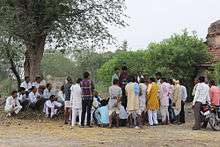Caste panchayat
Caste panchayats are caste-specific juries of elders for villages or higher-level communities in India.[1] They are distinct from village panchayats in that the latter, as statutory bodies, serve all villagers regardless of caste, although they operate on the same principles. A panchayat can be permanent or temporary.[2]

The term panchayat implies a body of five (Sanskrit: Panch) individuals, although the number may vary in practice. The number is kept odd to ensure there is no tie when a decision is made. Panchayat members are appointed by consensus.[3]
Responsibilities
Traditionally, panchayats have adjudicated disputes involving caste members in open meetings. The issues brought before these bodies can include: managing temples and schools, property disputes, marital relations, and breaches of community rules (such as extravagant spending on weddings[4] or the eating, drinking, or killing of certain animals, such as cows). Penalties include monetary fines, offering a feast to the caste members or to Brahmins, or temporary or permanent excommunication from the caste. Pilgrimage and self-humiliation are also occasionally imposed. Physical punishment was levied on occasion but is now uncommon.[2]
When the Evidence Act was passed in 1872,[2] some caste members began to take their cases before civil or criminal courts rather than have them adjudicated by the caste panchayat.[5][6] Nevertheless, these bodies still exist and exert leadership roles within their respective groups.[7][8][9]
Historical mentions of panchayats include the Parsi Panchayat in 1818,[10] the Aror Bans Panchayat at Lahore in 1888,[11] and the Prachin Agrawal Jain Panchayat of Delhi, founded in the late 19th century, which runs Delhi's famous Bird Hospital[12] and some of its oldest temples.
Khap
A Khap is a clan, or a group of related clans, mainly among the Jats of western Uttar Pradesh and eastern Haryana.[13][14] The term has also been used in other communities.[15] A Khap panchayat is an assembly of Khap elders, and a Sarv Khap (literally, "all Khaps") meeting is an assembly of many Khaps.[16][17] A Khap panchayat is concerned with the affairs of the Khap it represents.[18] It is not affiliated with the democratically elected local assemblies that are also termed panchayat, and has no official government recognition or authority, but it can exert significant social influence within a community.[19] Baliyan Khap, led by the late farmer's leader Mahendra Singh Tikait, is a well-known Jat Khap.[20]
References
- ↑ Mullick, Rohit; Raaj, Neelam (9 September 2007). "Panchayats turn into kangaroo courts". The Times of India. Archived from the original on 7 June 2015.
- 1 2 3 "Panchayat Indian caste government". Encyclopædia Britannica, Inc. Retrieved 22 March 2016.
- ↑ Justice, Human Rights and Premchand’s Panch Parmeshwar By CHARANJEET KAUR | 9 Dec 2012]
- ↑ Jain Panchayat Frames Regulations to Check Lavish Weddings, Kiran Tare, The New Indian Express, 19th December 2014
- ↑ Panchayat: Indian caste government (article 9374468), Encyclopædia Britannica, about "caste panchayats"
- ↑ Randeria, Shalini (2006). Civil society: Berlin perspectives, Chapter 9, "Entangled histories: Civil society, caste solidarities and legal pluralism in post-colonial India". Bergahn Books. pp. 213–226. ISBN 184545-064-7.
- ↑ Kumar, Vijay (1989). Scheduled caste panchayat pradhans in India: A study of western Uttar Pradesh. Ajanta. p. 183. ISBN 8120202627.
- ↑ Dube, SC (1955). India's Villages (PDF).
- ↑ Robert, Hayden (1984). "A Note on Caste Panchayats and Government Courts in India : Different Kinds of Stages for Different Kinds of Performances:" (PDF). The Journal of Legal Pluralism and Unofficial Law. 16 (22): 43–52. doi:10.1080/07329113.1984.10756282. Archived (PDF) from the original on 7 June 2015.
- ↑ Rhetoric and Ritual in Colonial India: The Shaping of a Public Culture in Surat City, 1852-1928, Douglas E. Haynes, University of California Press, 1991, p. 77-79]
- ↑ Short Ethnographical History of Aror Bans [panchayat]: According to the Questions, Issue 2 Volume 756 of Tract (India Office Library) Virajananda Press, 1888]
- ↑ A Jain hospital exclusively for birds, D.N.Jha, MeriNews, 20 May, 2008
- ↑ क्या है खाप पंचायत, क्यों है उसका दबदबा?, Atul Sagar, BBC 5 August 2009
- ↑ Identifying The Centripetal And Centrifugal Forces Through Khap Panchayats In Haryana-An Analysis Satpal Singh, Dalbir Singh, IOSR Journal Of Humanities And Social Science (IOSR-JHSS) Volume 16, Issue 4 (Sep. - Oct. 2013), PP 109-116
- ↑ अब उतपति श्रावकनु के, षांप गोत की जेम |
भई सु पोथिनु देषि करि, वरनन है कवि तेम ||६८२||
आगैं तो श्रावक सवै, एकमेक ही होत |
लगे चलन विपरीति तव, थापे षांप अरु गोत ||६८३||
थपी वहैतरि षांप ऐ, गांम नगर के नांम |
जैसैं पोथनु मैं लषी, सो वरनी अभिराम ||६८४||
Describes the 84 Jain communities, Buddhi-Vilas, Bakhtaram Sah, Samvat 1827, (1770 AD) - ↑ Haryana’s biggest khap panchayat scripts history, allows inter-caste marriages, Manveer Saini,TNN | Apr 21, 2014,
- ↑ The Jats of Northern India Their Traditional Political System—II, M C Pradhan, Economic and Political Weekly, December 18, 1965
- ↑ खाप पंचायतों का हृदय परिवर्तन! अंजलि सिन्हा, Sahara Samay, 26 Apr 2014
- ↑ Kaur, Ravinder (5 June 2010). "Khap panchayats, sex ratio and female agency | Ravinder Kaur". Academia.edu. Retrieved 31 March 2013.
- ↑ Muzaffarnagar riots: A Jat family protected 70 Muslims in Fugna village, India Today, September 14, 2013
Further reading
- Sangwan, K. S. (2008). "Khap Panchayats in Haryana". In Kannabiran, Kalpana; Singh, Ranbir. Challenging The Rules(s) of Law: Colonialism, Criminology and Human Rights in India. SAGE. ISBN 978-0-76193-665-7.